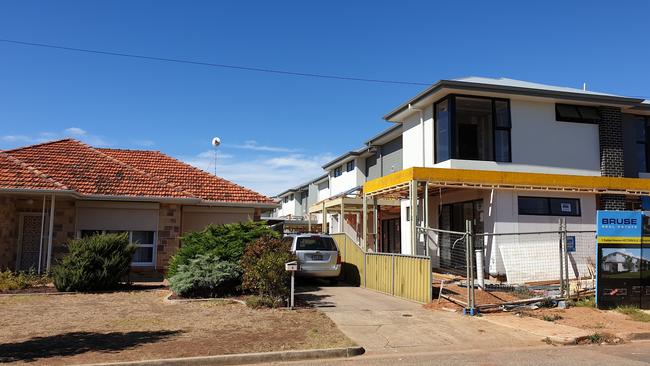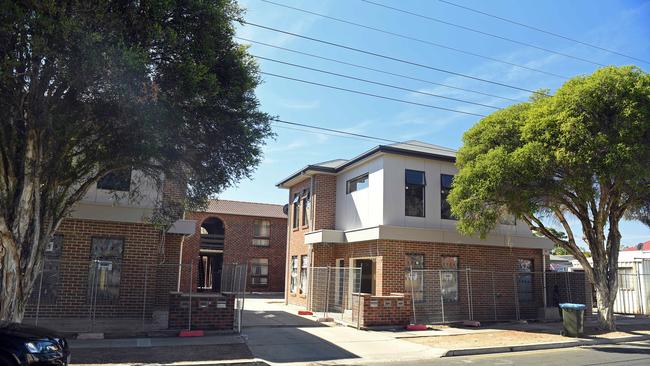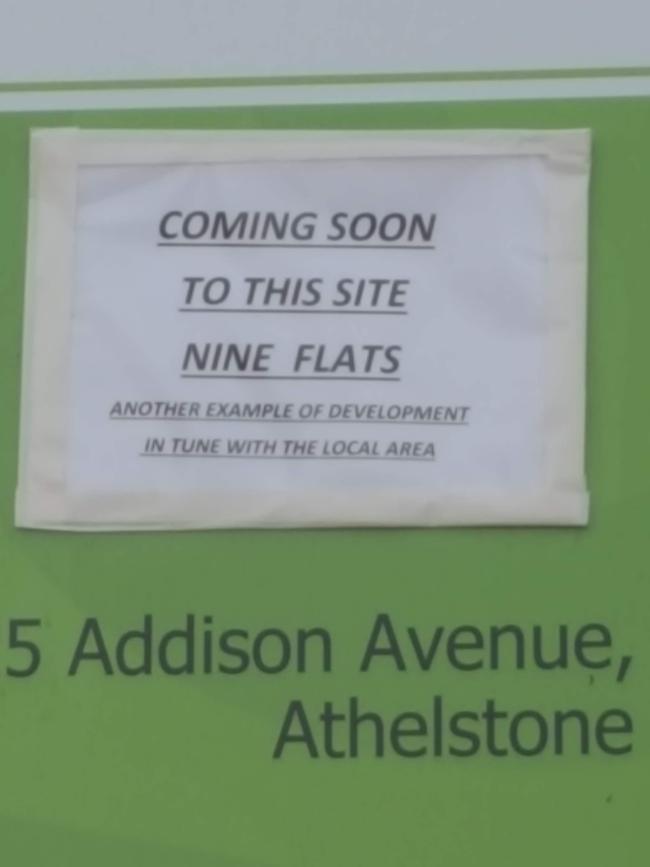Revealed: The Adelaide suburbs feeling the squeeze from urban infill
Wrecking balls and townhouses are fast becoming the new normal for Adelaide’s suburbs. But is the urban infill revolution moving too fast to keep our communities healthy and happy?

Local
Don't miss out on the headlines from Local. Followed categories will be added to My News.
- South Australia’s subdivision hot spots
- Campbelltown among areas missing out on funding for parks
- Master Builders predicts fall in housing approvals
Within earshot of buses rumbling down the O-Bahn is one of the last remaining former farming homesteads of Campbelltown.
The 124-year-old bluestone building, situated on a 2260 sqm block, has remained a rare relic of a neighbourhood which was once dominated by vast expanses of market gardens.
But the wrecking ball is coming.
The Hart St property sold last year for a record price for the north eastern suburb of $1.75 million as part of a forced sale to recoup debts of its owner Agape Ministries doomsday cult leader Rocco Leo.
A company backed by businessman and property developer Nicho Teng, who is a major sponsor of Port Adelaide Power, plans to raze the site and build 14 two-storey townhouses.
Across the road demolition has started on a 1960s cream-bricked house which will be replaced by four townhouses in a housing churn that is leaving few streets across Adelaide’s north east untouched.

Garry Pearce, 70, is bracing for similar change on his quiet tree-lined street, a short stroll from Linear Park.
Mr Pearce and his wife Marilyn moved into a single-storey house on Osborne St in 1973 as newlyweds.
More recently they relocated into a modern house they built on a neighbouring block, with four bedrooms and a three-car garage, to give Mr Pearce enough space to tinker.
They have a small backyard and the laughter of students playing at neighbouring East Marden Primary School reminds Mr Pearce of his grandchildren who live interstate.
Last month he was among six residents who unsuccessfully argued at a council meeting against the approval of 12 two-storey houses on a 2800 sqm block opposite his house.
Concerns were that the development did not have enough parking, would put pressure on existing infrastructure, and would detract from the amenity of area, which is predominantly detached houses on large blocks.
Mr Pearce has calculated that the proposal would increase the number of houses in the street by 40 per cent.
“Infill in its concept is not bad, what we’re arguing about is the volume of infill — regeneration should be evolutionary, not revolutionary,” he said.
“This is a revolutionary development because of its size and character; it doesn’t fit with the building character. I’d be happy with six (houses) that would be fine.”

The pace and scale of infill housing across Campbelltown has been fuelled by planning changes in 2014, driven by the former Labor government, to curtail urban sprawl, regenerate suburbs, provide more housing diversity and keep new housing close to shops and major transport.
Large across Campbelltown Council, which includes suburbs Newton, Paradise, Magill, Rostrevor and Athelstone, have become fertile ground for developers who are allowed to build properties as small as 150 sqm, or the size of a tennis court.
But existing residents have complained about overshadowing, lack of privacy, parking pressure on streets never designed for medium-density living and loss of mature trees.
The backlash has forced the council to revisit planning guidelines with a proposal out for public consultation that would increase minimum block sizes to 250 sqm, increase parking in new medium-density developments, increase setbacks to neighbours and require at least 8 m3 of internal storage.
Council chief executive Paul Di Iulio said the changes, if endorsed by Planning Minister Stephan Knoll, would reduce the number of houses being built in the area.
Mayor Jill Whittaker said the significant residential growth in the area had occurred “quickly, haphazardly and with detrimental” impact on residents.
“Fine tuning the Development Plan provisions will have significant benefits for the quality of life for residents allowing medium density developments more in keeping with the much loved character of the area,” she said.
A community meeting, attended by 200 people, that if all went to schedule the could be in place by October.
But there is not legislative time frame for which the Minister has to make a decision.

Marion Council responded to a barrage of complaints about overdevelopment in some neighbourhoods by proposing to also increase minimum block sizes.
But the proposed amendments to its development plan — prepared after two years of community consultation — are yet to be ratified, 16 months after being tabled with the previous Labor government.
Mayor Kris Hanna said the plan was to “limit infill, not stop it”.
“I would say in terms of complaints that come across the mayor’s desk, it’s (infill impacts) probably the single biggest source of complaints,” he said.
“We don’t mind grandma and grandpa dividing the old family home into two, but time and again we’ve seen four houses where there was one; it’s greedy and causing terrible parking problems as much as anything else.
“We’ve spoken to Stephan Knoll about it (approving the changes) on at least a couple of occasions and we still don’t have an answer.”
He said the council receives about 2500 development applications a year, meaning a large number of projects they were seeking to control were still being approved.

But there are signs that the construction market is cooling.
Planning Department land supply figures show the number of proposed new subdivided lots in the six months to December had fallen by 36 per cent from 5892 to 3781.
The number of proposed lots were down by 7 per cent from 10,377 in 2017 to 9673 in 2018.
Dwelling approvals decreased in the second half of 2018, falling 14 per cent from 6410 to 5488 when compared with the previous six months
The Master Builders Association’s Building and Construction Industry Forecasts report, released in January, suggests the number of new homes will fall steadily over the next four years, from 11,654 in the current financial year to just 7580 in 2022-23.
Apartment and unit construction in SA is expected to fall by 43 per cent, from 3739 units to 2141, while detached housing is expected to fall by 31 per cent to 5438 new builds.
Architect Alberto D’Andrea, whose company has designed dozens of medium-density buildings across the Campbelltown Council area, said his office had seen a big “decrease” since Christmas in new in work for new multi-dwelling sites.
“There are a number of factors, sales have slowed down and also finance for these projects has become a lot tighter,” he said.
“We are still doing a number but nowhere near before when we couldn’t keep up.”
He said 70 per cent of his clients were developers with Chinese backgrounds who saw Campbelltown as a “number one area” to maximise profits.
“You can make some money there and prices have steadily gone up, the dwellings and better quality units are selling for $550,000 to $600,000,” he said.

This is underlined by figures released by Land Services SA showing that blocks of less than 200m2 yield highest returns for investors of an average $1330 sqm across Adelaide — more than $500 more than blocks of between 201 sqm and 300 sqm.
Mr D’Andrea said he generally supported Campbelltown’s push to increase minimum block sizes, saying it should lead to better design and allow for increased landscaping.
“In my experience there is a great thrust to move forward and increase density and development in a particular location, but what happens when they (councils) see the result is they review and cut back the intensity,” he said.
“The same thing happened at Prospect Council along Churchill Road where all the apartment buildings were going up.”
Tamir Dunning, director of Tamir Dunning Real Estate, has planning approval for nine two-storey houses on a 1800 sqm block in Athelstone, facing south towards Black Hill Conservation Park.
The council described the project in its planning report as the first of its type in the area.
Not everyone was happy with a note placed on advertising hoarding reading: “Coming soon to this site nine flats another development in tune with the local area”.
Mr Tunning cited “profitability” when asked why he chose to build the maximum number of houses permitted on the block.
“At the end of the day it’s a business, it’s making money,” he said.
He said there was a “glut” of properties across the Campbelltown area and that quality would determine which properties sold.
He said not everyone wants a house on a large block and that would attract people that want low maintenance and convenience.
“Perhaps they grew up in the area and can’t afford a big house in Athelstone anymore,” he said.

Proposed subdivided lots
Jan — Jun 18: 5892
July — Dec 18: 3781 (-36 per cent)
2017: 10,377
2018: 9673 (-7 per cent)
Dwelling approvals
Jan — Jun 18: 6410
July — Dec 18: 5488 (-14 per cent)
2017: 12,195
2018: 11,898 (-7 per cent)
Approvals (17/18)
Adelaide — 700
Burnside — 940
Campbelltown — 909
Charles Sturt — 2230
Gawler — 492
Holdfast Bay — 842
Marion — 1826
Mitcham — 1548
NPSP — 885
Onkaparinga — 2905
Playford — 1084
Port Adelaide Enfield — 2193
Prospect — 438
Salisbury — 1415
Tea Tree Gully — 1878
Unley — 777
Walkerville — 167
West Torrens — 1492
(Source: Council data lodged with DPTI)
Campbelltown Council*
Residential Flat Buildings — Current (Proposed)
Average dwelling size — 150 sqm (250 sqm)
Frontage — 15m (18m)
Row dwelling
Dwelling size — 150 sqm (250sqm)
Frontage — 5m (7m)
Minimum 8 cubic metres of storage per dwelling on sites of 300 sqm or less and in residential flat buildings, row dwellings and group dwellings.
Setbacks to neighbours will be increased as well as off-street parking
*changes specifically to properties within 250m of a neighbourhood, district centre of major transport corridor (was previously 400m) and in areas of Campbelltown, Newton, Paradise and Magill
Norwood Payneham & St Peters
RFB
Dwelling — 250 sqm average exclusive of common areas
Frontage — 18m
Row dwelling
Dwelling — 300 sqm (single garage), 250 sqm (rear access garage)
Frontage — 7m/6m with rear vehicle garage access
Tea Tree Gully Council
RFB
Dwelling — 300 sqm
Frontage — not specified
Row dwelling
Dwelling — 225 sqm (single-storey), 200 sqm (two storeys)
Frongate — 5m (12m to an arterial road)


